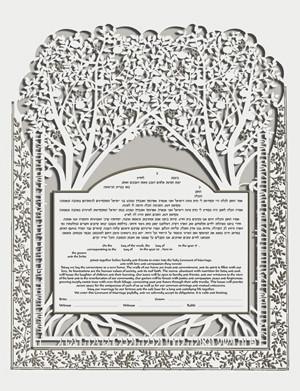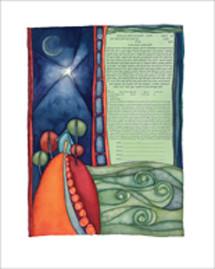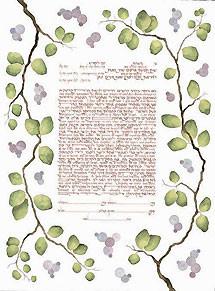In order for your ketubah to be valid, it must be filled in with your names, your parents' names (more on that later), and the date and location of your wedding -- a process known as "ketubah personalization." Some couples begin to fret when they learn about the preparations necessary to have their ketubah filled in. This guide is here to help you simplify the process and relieve your ketubah jitters.
A ketubah, or Jewish wedding contract, is usually offered with several pre-written text options. These ketubah texts contain "blanks" that must be filled in with your personal information: your names, your parents' names, and the date and location of the wedding. You generally have two choices when deciding how to have your ketubah personalized:
When you purchase ketubah personalization from us, your personal information is filled in in a style that matches the print on the document. (Keep in mind that there are a few ketubah artists who do not offer ketubahs without personalization -- rather they can only be purchased with your information already filled in. If the ketubah you choose does not have "No Personalization" option, then this is likely the case for that ketubah.) Talk to your wedding officiant about his or her preference about filling in your ketubah.
If you've decided to purchase personalization -- the most common choice -- you need to write all of your personal information on a ketubah personalization worksheet. To download the worksheet, simply browse your chosen ketubah's product info page and click the button that reads "Click Here for Worksheet and Instructions." See an example of a ketubah product info page here.

Each ketubah is produced via lasercutting, and can include your parents' names in English as well as Hebrew
It depends on the ketubah artist! Some artists fill in the ketubah with hand-calligraphy, while others use computer print. Have a look at the list below for a few examples of ketubah artists and their respective personalization techniques.
| Ketubot Personalized by Hand Calligraphy: | Ketubahs Personalized by Computer Print: |

Artist Rachel Deitsch offers modern ketubah designs that include your parents' names in English as well as Hebrew
In general, all ketubot that contain Hebrew text will include your parents' names. Whether or not your ketubah will include your parents' names in English varies by ketubah design and artist. If it is not clear in the ketubahs description, feel free to contact us and we'll let you know. In days of old, Jewish people were referred to by their first and middle names, and the name of their father. To abide by this ancient naming convention, your names will appear in this fashion on your ketubah -- usually along with your mother's name, as a more recent addition. The Hebrew word for "son of" is "ben," the word for "daughter of" is "bat," and the word for "and" is "ve." The following are two examples of Hebrew names as they might appear on a ketubah -- transliterated into English for the sake of explanation:
Bride:
Rachel Yehudit bat Yitzchak Nachum ve Shoshana Leah
Groom:
Shmuel Ze'ev ben Avraham David ve Rivka Tzipora
Traditionally, a Jew by choice uses either "Avraham Avinu" ("our father Abraham") or "Avraham ve Sarah" ("Abraham and Sarah") as their parents' names. If you're not sure how your names should appear, talk with your wedding officiant about what he or she feels is appropriate.
A ketubah is generally signed at a ceremony before the wedding. A small gathering of close family and friends come together, and the wedding officiant coordinates the signing of the ketubah.
Orthodox Perspective:
According to Ashkenazic Orthodox Jewish law, a Jewish wedding ketubah is considered binding once it has been signed by the two witnesses. The signatures of the bride, groom and wedding officiant are a modern addition to the ketubah, and are not required to make the ketubah binding. This is because, in ancient times, the groom would read the Aramaic document aloud, and two adult males -- unrelated to bride or groom -- would sign the document, attesting to the groom's verbal agreement to the ketubah contract. For this reason, many "Aramaic Only" ketubot (without any English text) only have signature spaces for the two witnesses, without any lines for the bride, groom or officiant. Often, the witness signature area is simply a set of spaces between the Aramaic words, without actual lines. The witnesses sign between two Aramaic words, which appear at the end of the Aramaic section, as seen here:

Modern Ideas and Options:
These days, when a ketubah includes an English text, there are usually lines for the bride, groom and wedding officiant to sign. Each ketubah artist decides the placement of these lines, and whether or not they include written designations for each line. Artists who produce their work via computer-print giclee process often provide options for the signature lines, where you can choose the number of witnesses, and whether the officiant line should read, "Cantor," "Rabbi," "Judge," etc. These options are usually indicated on that artist's ketubah worksheet.
It is important to discuss signature lines with your rabbi or wedding officiant, especially if you are being married in an Orthodox or Conservative environment.

Ketubah Artist Stephanie Caplan
personalizes her ketubot by hand, in uniquely stylized calligraphy
Orthodox Perspective:
According to Ashkenazic Orthodox law, the two witnesses must be adult, male, observant Jews, and unrelated to the bride or groom.
Modern Ideas:
In more liberal environments, as in Reform or Reconstructionist communities, the rules for witnesses tend to be relaxed, and often allow for women and non-Jewish wedding guests to serve as witnesses.
In all cases, if a ketubah will be signed at your wedding, it is very important that you discuss your choice of witnesses with your rabbi.
We hope this article has helped to answer your questions.
Feel free to contact us for further information on our ketubah and ketubah personalization services.
(818) 704-7100
customerservice@shalomhouse.com
Mazal Tov on your wedding from Gallery Judaica!